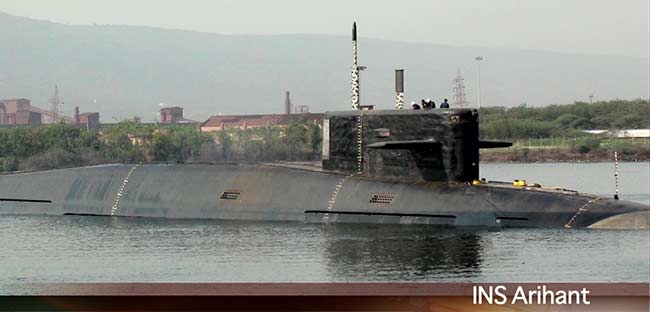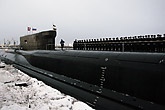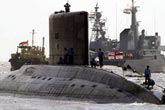Arihant stirs up the ocean

The first clear image of INS Arihant, taken by NDTV. Photo: NDTV snapshot
In June 2012 a nuclear-powered attack submarine of the Russian Navy quietly entered the Gulf of Mexico. Armed with long-range nuclear cruise missiles, the Akula class vessel operated undetected for several weeks and its movement in strategic US waters was only confirmed after it left the area. The silent Akula left a lot of red faces in the American defence establishment in its wake.
In November 2013 Russia launched its advanced stealth diesel-electric Novorossiysk. The Project 636 submarine is said to be virtually undetectable when submerged. “Our potential opponents call it the ‘Black Hole’ due to the very low noise emission and visibility of the submarine,” Konstantin Tabachny, the captain of the Novorossiysk, told the media. “To be undetectable is the main quality for a submarine. And this whole project really fits its purpose.”
Considering that the Russian scientists and experts behind these stealthy subs played a key role in the development of the Arihant, India’s first SSBN (ship submersible, ballistic missile, nuclear powered) submarine promises to be a potent vessel.
After decades of development, the 367 ft – as long as 10 buses parked end to end – Arihant was finally launched on December 15. It is a measure of how jealously India guards its strategic submarine that when the jet black beauty sailed out of the naval dockyard in Visakhapatnam, the Indian Navy and Indian Air Force deployed their MiG-29K and Su-30 MKI combat jets around the harbour while the Poseidon P-8I maritime surveillance and attack aircraft from the nearby naval base at Arakkonam sanitised the area for any hostile underwater activity. Further, reports India Strategic warships from the Eastern Command provided protective cover.
The excitement in India’s defence establishment is understandable. Like the BrahMos, the Arihant is a rare example of a successful strategic weapon made from scratch within the country. The 6000 tonne submarine will take India to an elite league. According to Richard Sharpe of Jane's Fighting Ships, a nuclear submarine will give India a "colossal advantage" over its neighbours. “Facing a nuclear submarine is a nightmare; it has unlimited endurance and mobility and there's no place for a surface ship to hide,” he writes.
Until now India has blissfully carried on without a credible second strike option. This means if China – or for that matter any other country – launches a surprise first strike and decapitates the country’s land based nuclear missiles and its nuclear armed aircraft, there’s very little India can do except throw in the towel.
Having an SSBN changes the equation. It guarantees a nuclear first strike will not destroy India’s ability to strike back. Lurking at the bottom of the oceans and constantly moving, even a handful of SSBNs can sow doubt in the enemy’s mind that some of India’s sea-launched strategic missiles will be launched in retaliation. The planned fleet of five Arihant class SSBNs will thus complete India’s strategic triad, giving the country’s military the second strike option.
The first Arihant class submarine will carry 12 K-15 ballistic nuclear missiles that can be launched even under ice caps. Tested in 2008, the K-15 will be armed with a nuclear warhead that can be targeted at a distance of 750 km. The low range means the sub will have to venture close to enemy waters before launch. However, a 3,500 km range missile is already in development.
India’s quest for strategic parity with the leading nuclear powers began as early as the 1950s. As noted by Eric Arnett, a researcher at the Stockholm International Peace Research Institute, “The history and implications of (nuclear powered submarines) for Indian maritime strategy suggest that the US presence in the Indian Ocean was a stronger motivation for the programme.”
The approval of the construction of an SSBN dates back to 1970, but as is usual with Indian defence projects, nothing came off it. The project was revived in 1985 and in 1989 DRDO sought design assistance from former engineers and defence workers of the former Soviet Union. Several Russian naval engineers have been in India since 1991.
By 1996, when India had spent $285.7 million on the nuclear submarine, work on the project came to a crawl because of pressure from the US. The Federation of American Scientists says ASEAN also wanted India to stop work on the ATV as a condition for entry into ASEAN and for India to be invited to future Asia-Europe summits. The European Union was behind the demands put up by ASEAN.
The Russians soon understood the US game plan. By stopping Moscow from selling key technologies to India, the Americans managed to starve Russian industry of much needed funds while at the same time it placed major roadblocks in India’s ability to develop strategic weapons. This not only had the effect of creating a rift between Russia and India, it also allowed the Americans a foot in the door in India’s defence market.
However, with the exit of the pro-American elements from the Kremlin, Russians came back in full strength. While Russian designers assisted in building the vessel, which is based on the Akula class hunter killer submarine, its nuclear-powered 80MW pressurised water reactor was developed by the Bhabha Atomic Research Centre with assistance from a design team from Rubin, the Russian submarine-design bureau.
Although the reactor was “designed, fabricated and executed in India” by Indian industry and under the direction of Indian scientists, the chairman of India’s Atomic Energy Commission, Dr Anil Kakodkar, told the media in 2009: “I would also like to thank our Russian colleagues. They have played a very important role as consultants, they have a lot of experience in this so their consultancy has been of great help so that I think we should acknowledge.”
In fact, Russia's contribution has been acknowledged by the Government on a number of occasions, including in 2009 by former prime minister Manmohan Singh. The Russians also helped in building the naval base in Visakhapatnam, where a section of the officers’ mess is named Kremlin.
Russia helped with another significant aspect – crew training. Even as the Arihant’s development was plodding along, India prepared for operating an SSBN by leasing a Charlie class nuclear-powered submarine Chakra from Russia in January 1988. However, bowing to pressure from the US, Moscow refused to extend the lease and the sub returned to Vladivostok in January 1991.
The crew of Arihant is being trained on a brand new 12,000 tonne Akula-II Class submarine. Leased from Russia for 10 years in 2011, the submarine is also named Chakra.
In the 1971 India-Pakistan war, as the Indian Army was thundering down the road to Lahore, the US and British fleets made a threatening pincer against India. While the US Seventh Fleet from Southeast Asia sailed towards Calcutta, a British flotilla from Madagascar steamed towards western India. The Indian Air Force was on alert after receiving intelligence that American warplanes might attack the Indian Army’s communications in the west. However, the Soviet Pacific Fleet sailed into the Indian Ocean and threw a cordon around India, forcing the American and British warships to retreat.
Once a fleet of Arihant boomers start patrolling the waters around India, India can ensure no foreign navy will threaten it again.
All rights reserved by Rossiyskaya Gazeta.
Subscribe
to our newsletter!
Get the week's best stories straight to your inbox


